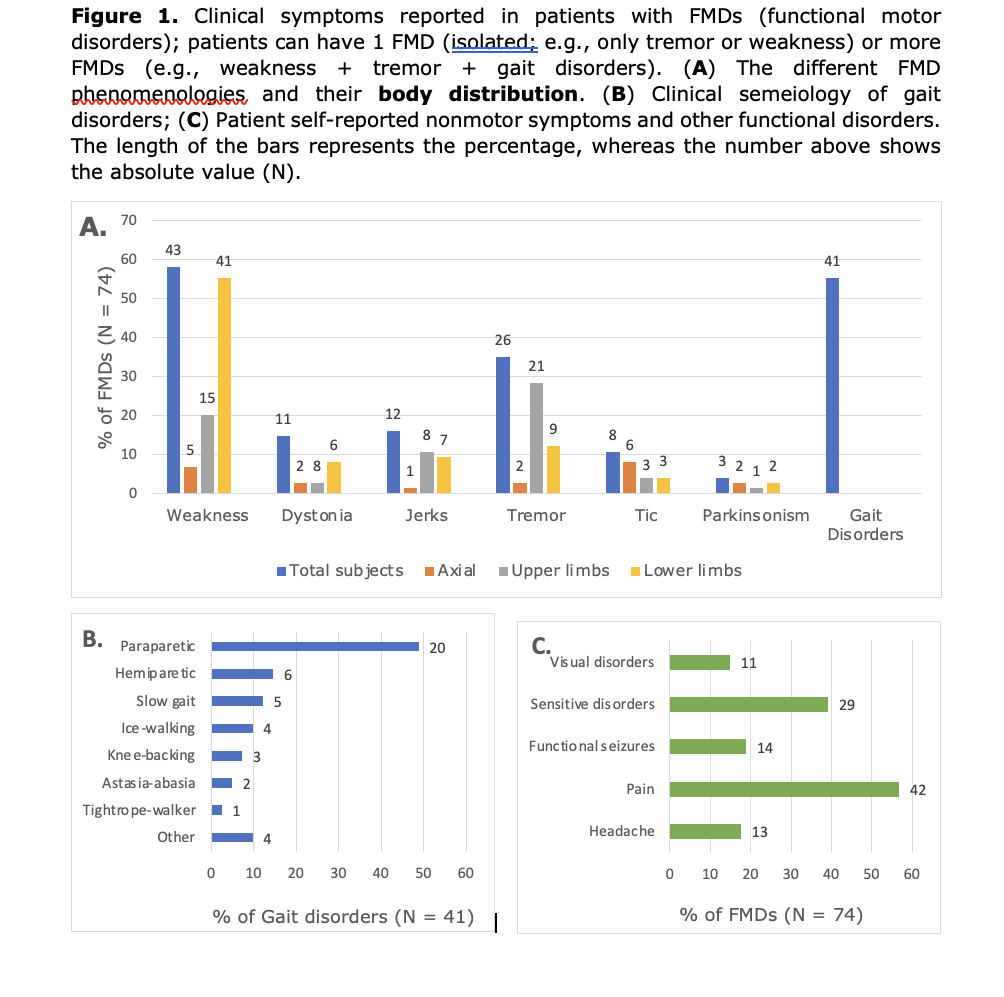Objective: The aim of this study was to describe FMDs clinical manifestations in pediatrics, including non-motor symptoms and other functional neurological disorders (FNDs) and to report the frequency of isolated and combined FMDs and their relationship with demographic and clinical variables.
Background: Functional Motor Disorders (FMDs) pose a growing diagnostic and therapeutic challenge in pediatric neurology. Despite a significant prevalence, the clinical presentation of pediatric FMDs remains poorly characterized, leading to frequent misdiagnoses and diagnostic delays in young patients.
Method: For this cross-sectional study, data were extracted from the Italian Registry of Functional Motor Disorders (n=32) and from the pediatric database of the Unit of Neuropsychiatry of Sapienza University of Rome (n=42), with consistent features, collecting 74 FMD pediatric (7-18 years) inpatients and outpatients, assessed by a complete neurological and psychiatric evaluation.
Results: Out of 74 FMDs (68.9% females; mean age at the onset of the symptoms 13.8± 2.31years) the most common phenotypes were weakness (58.1%, n=43) and gait disorders (55.4%, n=41) Among the hyperkinetic FMDs, functional tremor (35.1%; n=26) represented the highest expressed manifestations, then dystonia (14.9%, n=11); myoclonus/jerks (16.2%, n=12) and Tic (10.8%, n=8).
An isolated pattern was reported in the 45.9% (n=34), related to a significantly lower number of clinical referrals before the FMD diagnosis (p .001). Combined pattern was significantly associated with weakness (p.< 0.001), functional tic (p .006), visual and sensitive disorders (p <.001 and .039), and functional seizures (p .015).
The 75.7% of FMDs had associated at least one other functional symptom. Particularly, algic symptoms were reported in 74.4% of FMDs (n=55), including 17.6% (n=13) of headaches. Almost half of FMDs presented comorbid medical conditions, mostly represented by psychiatric diagnosis (32.4%, n=24). A history of childhood trauma (23%, n=17)) and family neurological disease (13.5%, n=10) was highlighted.
Conclusion: These data expanded the knowledge of FMDs clinical correlates in the pediatric age, mainly represented by an isolated pattern of functional gait disorders and weakness. Moreover, a need for a neuropsychiatric assessment was highlighted in pediatric FMDs patients, given the high frequency of non-motor symptoms and other FND, especially in patients with combined FMDs.
Clinical symptoms reported in patients with FMDs
References: 1. Harris RS Psychogenic movement disorders in children and adolescents: an update. Review Eur J Pediatr. 2019 Apr;178(4):581-585. doi: 10.1007/s00431-019-03317-8. Epub 2019 Jan 11. PMID: 30635706 DOI: 10.1007/s00431-019-03317-8
2. Canavese C, Ciano C, Zibordi F, Zorzi G, Cavallera V, Nardocci N. Phenomenology of psychogenic movement disorders in children. Mov Disord. 2012;27(9):1153-1157. doi:10.1002/mds.24947
3. Kozlowska, K.; Nunn, K.P.; Rose, D.; Morris, A.; Ouvrier, R.A.; Varghese, J. Conversion Disorder in Australian Pediatric Practice. J. Am. Acad. Child Adolesc. Psychiatry 2007, 46, 68–75, doi:10.1097/01.chi.0000242235.83140.1f.
To cite this abstract in AMA style:
V. Baglioni, C. Geroin, D. Esposito, F. Teatini, A. Tessitore, G. Calandra-Buonaura, M. Zibetti, R. Erro, F. Morgante, A. Albanese, F. Bono, M. Zappia, G. Defazio, E. Marcuzzo, A. Sandri, M. Tinazzi. Functional Motor Disorders in pediatrics: motor patterns and clinical correlates. [abstract]. Mov Disord. 2024; 39 (suppl 1). https://www.mdsabstracts.org/abstract/functional-motor-disorders-in-pediatrics-motor-patterns-and-clinical-correlates/. Accessed December 7, 2025.« Back to 2024 International Congress
MDS Abstracts - https://www.mdsabstracts.org/abstract/functional-motor-disorders-in-pediatrics-motor-patterns-and-clinical-correlates/

